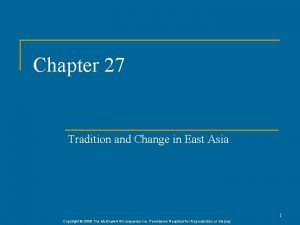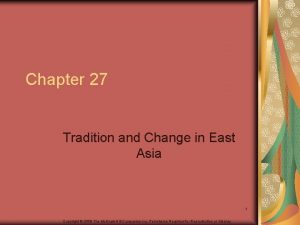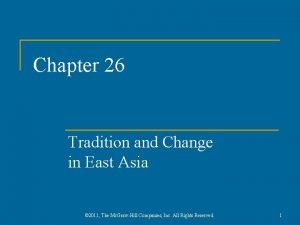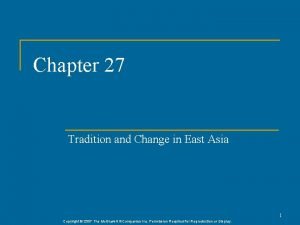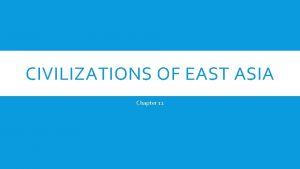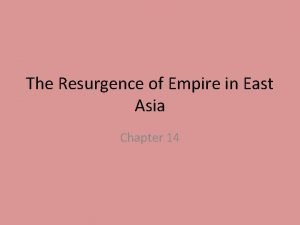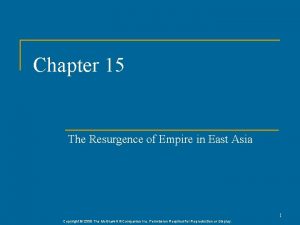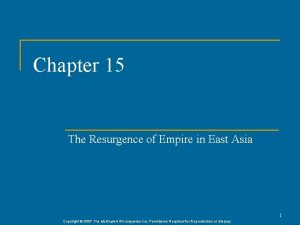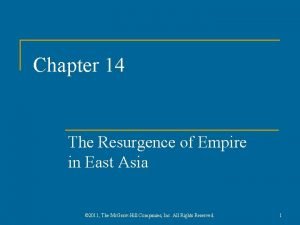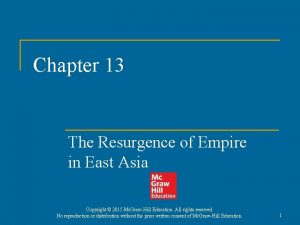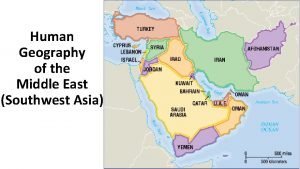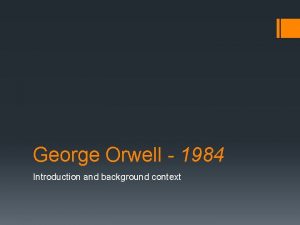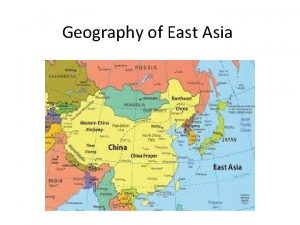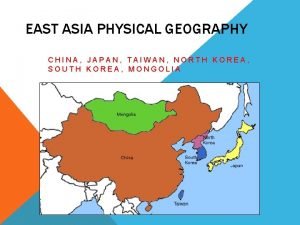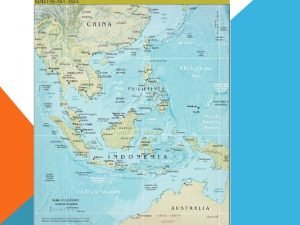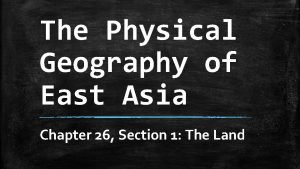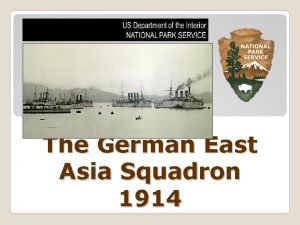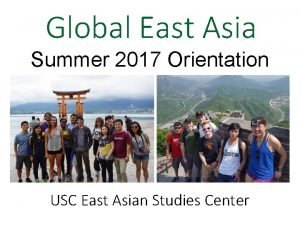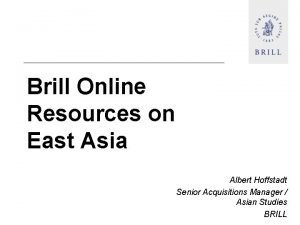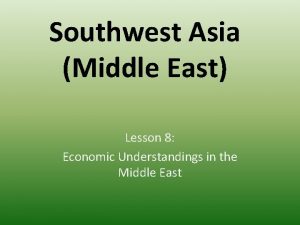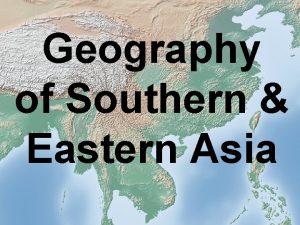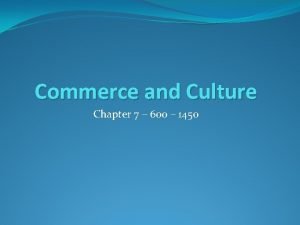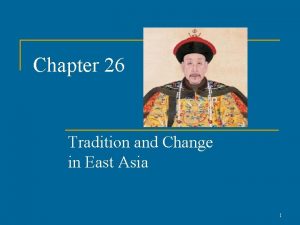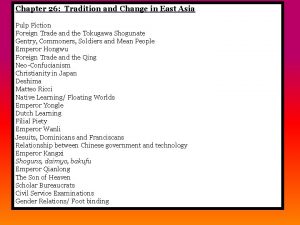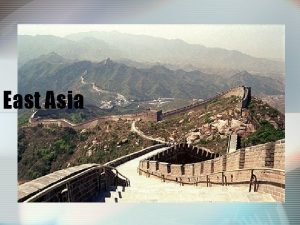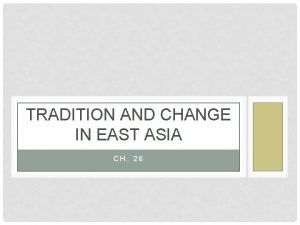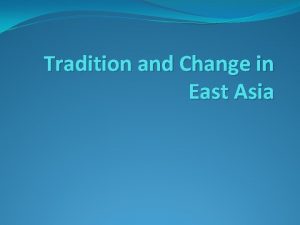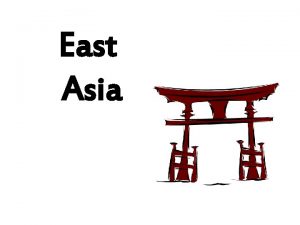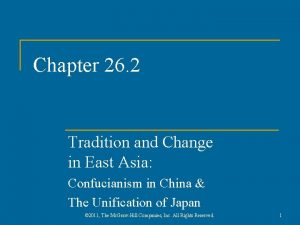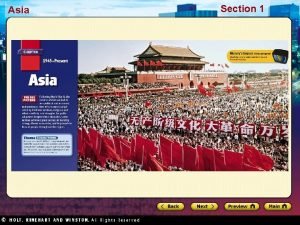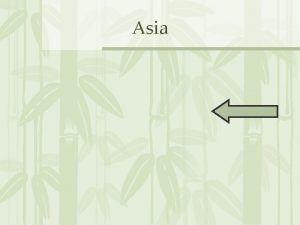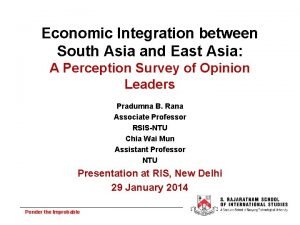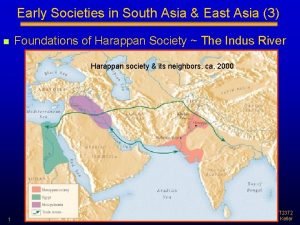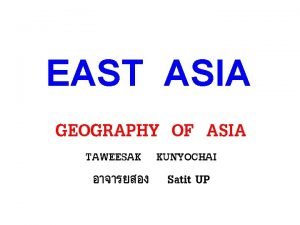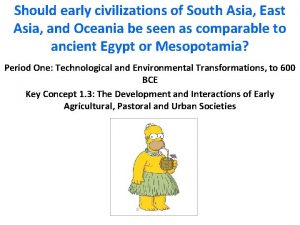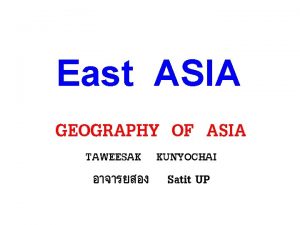Chapter 27 Tradition Change in East Asia A




























- Slides: 28

Chapter 27 Tradition & Change in East Asia

A New Era—The First “Global” Age! • European voyages sparked a new era of interaction and exchange in world history • Transoceanic encounters affected societies in different ways – European arrival in the Americas led to the disappearance of the Aztecs and Incas, a new racebased social class system, and coercive labor on plantations and in mines. – European interactions with Africa produced the Atlantic slave trade as well as political, social, and economic turmoil in Africa. • European interactions with East Asia were different—but HOW? And WHY?

Why was East Asia Different? • Geographic Isolation – West: Himalayas, Tibetan Plateau, Talkamakan Desert – North: Gobi Desert – East: Yellow Sea • Led to a strong native culture in China, Japan, and Korea • general mistrust of foreigners

Why was East Asia Different? • Philosophical, Religious and Social Traditions – Buddhism & Daoism • Individual journey, avoiding extremes, promote peace & harmony, etc. – Confucianism • Strong socio-political philosophy; practical & ethical • Social harmony could be restored with key relationships • Good government comes from placing wise & virtuous rulers in charge • Rulers should be counseled by scholars well versed in history, poetry, & literature

Why was East Asia Different? • Basic Supply & Demand! • Europeans demanded Chinese: – Tea – Silk – Porcelain – Lacquer-ware • Europe were supplying China with: – Exotic animals – Woolen textiles – Spices – SILVER!!

The Ming Dynasty “Restoration” • Yuan dynasty (Mongol rule) collapsed in 1368, due to decline in population from the plague, economic hardships, civil war, etc. • Rise of the Ming under Hongwu – Soldier, priest, and a thief (? !) – Drove Mongols out; created a new centralized state – Used mandarins to enforce laws – Trusted eunuchs, eunuchs appointing many as high advisors/palace bureaucrats • Restored Chinese rule, tradition & the civil service system!!!

The Ming continued… • Ming Rulers focused on: – – – Removing Mongol influence Reinstating Chinese traditions Centralizing administration Expanding civil service bureaucracy Expanding borders Forming alliances w/ neighboring areas • Vietnamese states • Yi kingdom in Korea – Repelling foreign invasions • Fortified the Great Wall – Added watch towers, signal towers, brick & mortar, etc. • Strengthened army

Chángchéng (“Long Wall”)

The “Forbidden City” (Palace of Ming & Qing

Decline of the Ming • 1520 -1560’s pirates & smugglers disrupted coastal and inland communities • Imperial government became inept & corrupt – Isolated in the “Forbidden City” (cut off from reality) – Entrusted govt. matters to eunuchs – Emperor distracted by entertainment/ harem/concubines – 17 th c. famines – Economic problems (caused by monetary policies; high taxes) – Peasant rebellions!! – Manchu invaders!!!

The Qing Dynasty • Poured in from Manchuria in 1644 • Notable Emperors: Kangxi, Qianlong (“enlightened rule”? ) • Manchu elites were schooled in Chinese language, Confucian thought, and poetry • Did not allow Chinese people to learn their language, go to their country, inter-marry etc. • Tensions between the Manchu and the Chinese were muted by strong leadership & adherence to the Confucian values and political system • Expansion of the empire—expansion in Tibet; added Nepal, Vietnam, and Burma as vassal states

Kangxi & Qianlong

How was Manchu rule (under the Qing Dynasty) similar to Mongol rule (during the Yuan Dynasty)? How was it different?

Economic Changes. . . • Coastal cities: Global trade fueled commercial expansion • Rural areas: Confucian traditions praised agricultural labor • New crops introduced (via Columbian Exchange)= maize, sweet potatoes, peanuts • Increased agricultural production & new crops created a population boom! • Population from 100 million to 160 million in 1600, surged to 225 million in 1700!! • Growth put tremendous pressure on resources • Large labor force drove wages/per capita income down

Population Growth Continues!

Isolation vs. Trade • European demand for Asian luxury goods led to influx of American & Japanese SILVER that fueled manufacturing • Commercial activities were highly regulated by gov’t. • 1656—imperial edict banned foreign trade; imposed isolation • Many Chinese merchants independently went to SE Asia to trade w/ European merchants • Commoners put pressure on gov’t. to lift trade ban (civil unrest; weakened imperial Manila (Spanish) Galleon

Ming & Qing Society • Ming rulers aimed to restore and maintain traditional ways • Stressed political & social stability (over progress) – Population growth caused rulers to focus on keeping the people fed, not on technological innovation, long distance trade, interaction with Europe, etc. • Increaded Patriarchy!! – Female infanticide – Resurgence of foot-binding


Ming & Qing Social Hierarchy • • • Emperor Scholar-bureaucrats Gentry Peasants & artisans Merchants “Mean people”—(beggars, slaves, prostitutes, & “boat people of Guangdong”) How is the social hierarchy in China different than it was in other places during this time? WHY is it

Neo-Confucianism Restored • Strong support of Neo-Confucianism created new climate of learning & discipline • Civil service examinations became more rigorous; scholar-gentry considered “elite” • Popular novels were looked down upon by Confucian scholars

Neo-Confucianism & Christianity • European Jesuit missionaries ( like Matteo Ricci) Ricci learned Chinese and Confucian classics to gain access & promote Christianity • Tried to show similarity between teachings of Jesus and Confucius • Few converts—Christianity (like Islam) could not be practiced along with Daoism, Buddhism, etc. • Emperor Kangxi “banned” Christian teachings • Eventually missionary efforts weakenedhow anddid ended Even though there were few converts, the spread of Christianity change China?

Unification of Japan • Japan had history of clan-based government & Medieval era brought the rise of feudalism • Rule by shoguns from 12 th -16 th c. • Emperor was seen as a living god (a figurehead); shoguns had real power • Sengoku— Sengoku “country at war”! • Tokugawa Ieyasu conquered rival clans & est. temporary “tent govt. ” (bakufu) bakufu that ended up lasting. . .

Tokugawa Japan • Tokugawa shoguns wanted to limit power of daimyo (lords) • Req. policy of “alternate attendance” (daimyo required to live in Edo alternate years) • Monopoly on gunpowder technology • Led to general stability & peace through Tokugawa period http: //www. hogaku. it/storia/azuchi_momoyama/map 2. gif

Isolation and Economic Change in Japan • Shoguns issued strict edicts restricting interaction with foreigners (Europeans brought gunpowder!) • Expelled merchants; forbade import of foreign books • Small numbers of Chinese & Dutch merchants could trade at Nagasaki under tight watch

Social and Cultural Change in Japan • Social structure changed (daimyo’s power decreased, merchants at bottom—as in China) • However, merchant wealth increased; often merchants bought into arranged marriages to improve standing • Neo-Confucianism became the “official” ideology of the Tokugawa bakufu • Also a push for “native learning” (Japanese tradition) that scorned influence from China • “Floating worlds” emerged in the cities (cultural centers w/ kabuki theatres, teahouses, brothels, and public baths) • The arrival of Dutch merchants brought Christianity (resented by shoguns) and the introduction of “Dutch learning”, which brought

Social Hierarchy in Tokugawa Japan

Social and Cultural Change in Japan

Japanese Geisha
 Chapter 27 tradition and change in east asia
Chapter 27 tradition and change in east asia Chapter 27 tradition and change in east asia
Chapter 27 tradition and change in east asia Chapter 26 tradition and change in east asia
Chapter 26 tradition and change in east asia Chapter 27 tradition and change in east asia
Chapter 27 tradition and change in east asia Chapter 11 civilizations of east asia
Chapter 11 civilizations of east asia China population density
China population density Chapter 14 the resurgence of empire in east asia
Chapter 14 the resurgence of empire in east asia Chapter 15 the resurgence of empire in east asia
Chapter 15 the resurgence of empire in east asia Chapter 15 the resurgence of empire in east asia
Chapter 15 the resurgence of empire in east asia Chapter 14 the resurgence of empire in east asia
Chapter 14 the resurgence of empire in east asia Chapter 13 the resurgence of empire in east asia
Chapter 13 the resurgence of empire in east asia Is middle east in asia
Is middle east in asia Oceania 1984 map
Oceania 1984 map Physical geography of east asia
Physical geography of east asia Physical geography east asia
Physical geography east asia Climate regions in east asia
Climate regions in east asia Physical geography of east asia
Physical geography of east asia The commander of the german east asia squadron was
The commander of the german east asia squadron was Buddhism and chinese culture
Buddhism and chinese culture East asia & sushi
East asia & sushi Easc usc
Easc usc East asia
East asia Lesson 8 middle east and south asia
Lesson 8 middle east and south asia Southern and eastern asia physical features
Southern and eastern asia physical features Chang'an
Chang'an West north west wind direction
West north west wind direction North american
North american East is east and west is west
East is east and west is west Weaving the web of an indian ocean world
Weaving the web of an indian ocean world
